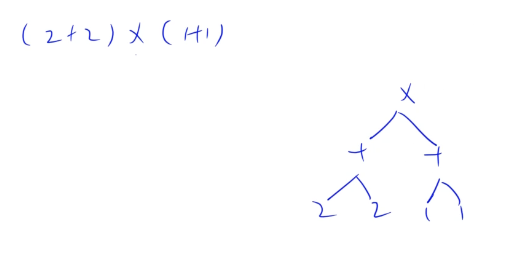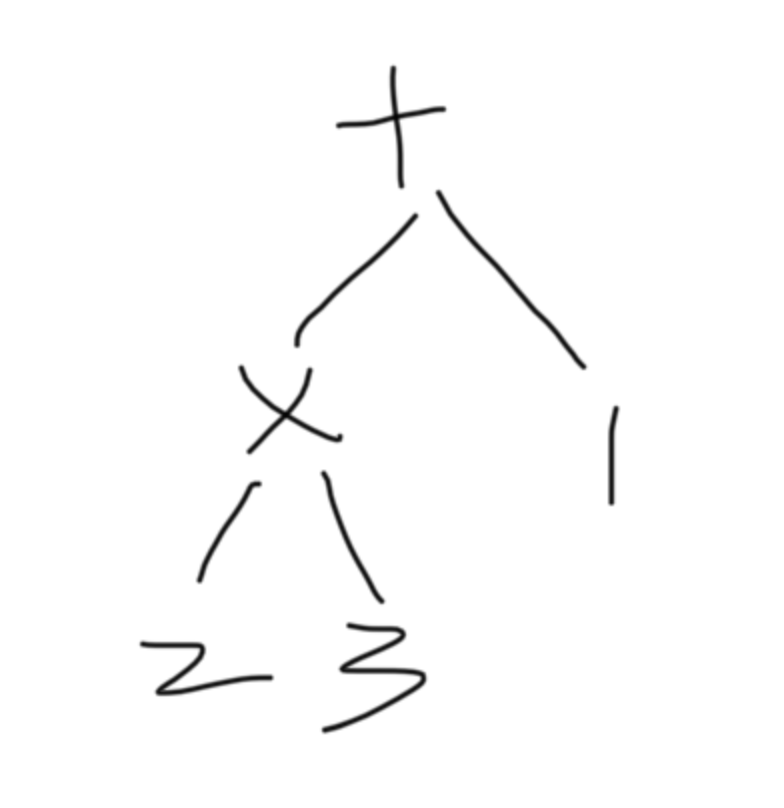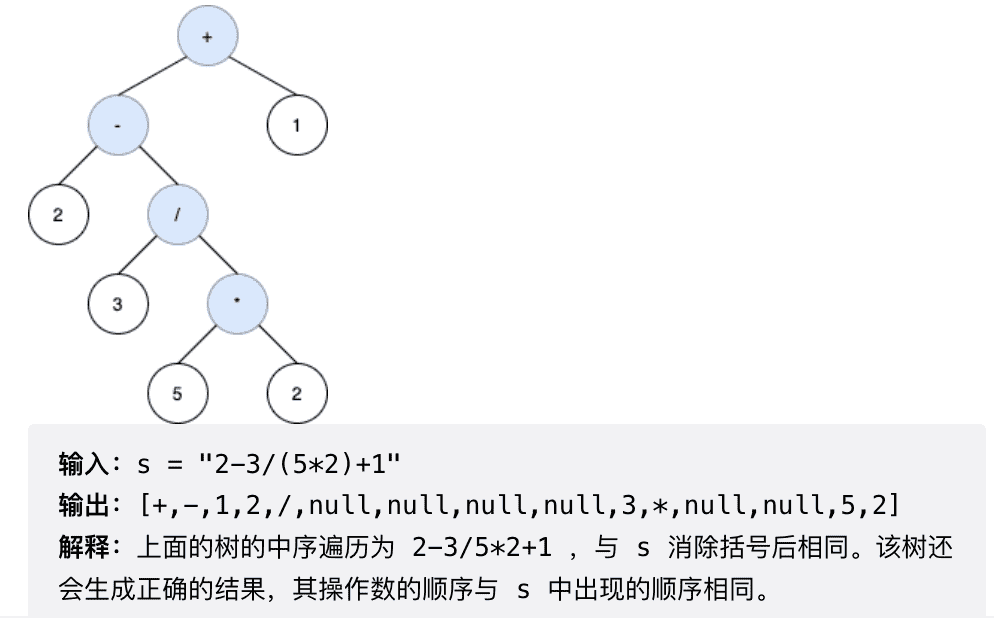栈的基本应用,表达式求值相关问题
acwing 3302. 表达式求值
给定一个表达式,其中运算符仅包含 +,-,*,/(加 减 乘 整除),可能包含括号,请你求出表达式的最终值。
算法基于中缀表达式,利用两个辅助栈:符号栈和数字栈。
例如:( 2 + 2 ) × ( 1 + 1 ) (2+2)\times(1+1) ( 2 + 2 ) × ( 1 + 1 )
表达式树,叶节点为数字,非叶节点为运算符。
后缀表达式 (也即对表达式树进行后序遍历 ): 2 2 + 1 1 + x,
结合后缀表达式便于理解。
扫描中缀表达式字符串str,对于每个ch:
如果ch代表数字,存入数字栈num 如果ch是左括号(,直接存入符号栈op 如果ch是右括号),将op中的符号依次 出栈,与num栈顶数字进行计算,直到op栈顶为左括号(,并将左括号弹出栈 如果ch是加减乘除符号+ - * / ,若op栈顶计算符 的优先级大于或者等于当前ch代表的计算符,循环 :计算符出栈,计算值 直到 op为空或者op栈顶为左括号(完成循环后,将当前ch存入op栈顶 完成扫描后,如果op栈不为空,则将操作符依次出栈,计算值。
关于算法流程的第4步,进入循环的条件,op栈顶的运算符优先级要是大于或者等于 ch
例如:2 × 3 + 1 2\times3+1 2 × 3 + 1
扫描到+时,op栈顶是乘号x,根据运算符的优先级,要先计算2 × 3 2\times3 2 × 3 +的左子树(计算左子树的值)。因此要先弹栈,计算值,再将+存入op栈中。
同理,要是优先级相等,相同优先级的运算是从左向右进行的,仍然可以先计算值。
反之,若优先级小于当前运算符,例如:2 + 1 × 3 2+1\times3 2 + 1 × 3 x时,直接入op栈。扫描完毕后,再依次弹出,计算值即可。
以下是代码模板,eval()函数是独立开的,涉及到别的运算,例如乘方、取余数等都可以用这套模板,更改eva()函数,再做细节调整即可。
1 2 3 4 5 6 7 8 9 10 11 12 13 14 15 16 17 18 19 20 21 22 23 24 25 26 27 28 29 30 31 32 33 34 35 36 37 38 39 40 41 42 43 44 45 46 47 48 49 50 51 52 53 #include <iostream> #include <stack> #include <unordered_map> using namespace std;stack<int > num; stack<char > op; void eval () int b = num.top (); num.pop (); int a = num.top (); num.pop (); int ans; char o = op.top (); op.pop (); if (o == '+' ) ans = a + b; else if (o == '-' ) ans = a - b; else if (o == '*' ) ans = a * b; else ans = a / b; num.push (ans); } int main () unordered_map<char , int > pr{{'+' , 1 }, {'-' , 1 }, {'*' , 2 }, {'/' , 2 }}; string str; cin >> str; for (int i = 0 ; i < str.size (); ++ i) { char ch = str[i]; if (isdigit (ch)) { int x = 0 , j = i; while (j < str.size () && isdigit (str[j])) { x = x * 10 + (str[j ++] - '0' ); } i = j - 1 ; num.push (x); } else if (ch == '(' ) op.push (ch); else if (ch == ')' ) { while (op.top () != '(' ) eval (); op.pop (); } else { while (!op.empty () && op.top () != '(' && pr[op.top ()] >= pr[ch]) eval (); op.push (ch); } } while (!op.empty ()) eval (); cout << num.top () << endl; return 0 ; }
update@2022年11月 5日 星期六 15时48分20秒 CST
和中缀表达式求值原理是类似的,都是用两个栈(一个操作数栈nums和一个操作符栈ops),解决表达式求值问题
本题相对简单,无需考虑运算优先级的问题
以下分析摘自@宫水三叶的Leetcode题解
从前往后处理 s,根据当前处理的字符为何值进行分情况讨论:
,:分隔符,直接跳过;t 或 f:操作数,添加到 nums 栈中;|、& 或 !:操作符,添加到 ops 栈中;(:子表达式的左端点,为了在我们从「双栈」中取出数值和符号计算时,可以知道某个子表达式计算完成,需要记录一下。往 nums 追加一个占位符号 - 来代指;):子表达式的右端点,代表一个子表达式的结束。可从「双栈」中取出符号和数组进行计算(在 ops 中仅取栈顶元素,代表当前子表达式的操作符;而在 nums 中则取到代表左端点的占位元素 - 为止),并将结果重新放入 nums 中。
java版完整代码
1 2 3 4 5 6 7 8 9 10 11 12 13 14 15 16 17 18 19 20 21 22 23 24 25 26 27 28 29 30 class Solution { public boolean parseBoolExpr (String expression) { Deque<Character> nums = new LinkedList <>(), ops = new LinkedList <>(); for (char ch : expression.toCharArray()) { if (ch == ',' ) continue ; if (ch == 't' || ch == 'f' ) nums.push(ch); if (ch == '&' || ch == '|' || ch == '!' ) ops.push(ch); if (ch == '(' ) nums.push('(' ); if (ch == ')' ) { char cur = ' ' , op = ops.pop(); while (!nums.isEmpty() && nums.peek() != '(' ) { char top = nums.pop(); cur = cur == ' ' ? top : cal(cur, top, op); } if (op == '!' ) cur = cur == 't' ? 'f' : 't' ; nums.pop(); nums.push(cur); } } return nums.peek() == 't' ; } public char cal (char a, char b, char op) { boolean x = a == 't' , y = b == 't' ; boolean ans = (op == '|' ) ? (x | y) : (x & y); return ans ? 't' : 'f' ; } }
逆波兰表达式又称后缀表达式,由波兰的逻辑学家卢卡西维兹提出。其特点是,没有括号,运算符号紧跟在与之相关的操作数后边
求后缀表达式的值
1 2 3 4 5 示例 1 : 输入:tokens = ["2" ,"1" ,"+" ,"3" ,"*" ] 输出:9 解释:该算式转化为常见的中缀算术表达式为:((2 + 1 ) * 3 ) = 9
计算后缀表达式比较简单,由于操作符紧跟在与之相关的操作数后边,无需考虑运算符号的优先级问题。这样,采用一个操作数栈即可解决问题
java代码
1 2 3 4 5 6 7 8 9 10 11 12 13 14 15 16 17 18 19 20 21 22 23 24 class Solution { public int evalRPN (String[] tokens) { Deque<Integer> nums = new LinkedList <>(); for (String str : tokens) { int num = 0 ; if (Character.isDigit(str.charAt(0 )) || str.length() > 1 ) { num = Integer.parseInt(str); nums.push(num); } else { int y = nums.pop(), x = nums.pop(); int cur = 0 ; switch (str) { case "+" : cur = x + y; break ; case "-" : cur = x - y; break ; case "*" : cur = x * y; break ; case "/" : cur = x / y; break ; } nums.push(cur); } } return nums.pop(); } }
中缀转后缀,加上后缀表达式求值其实就组成了完整的中缀表达式求值
只需借助操作符栈,原理同求解中缀表达式一模一样
完整代码
1 2 3 4 5 6 7 8 9 10 11 12 13 14 15 16 17 18 19 20 21 22 23 24 25 26 27 28 29 30 31 32 33 34 35 36 37 38 39 40 41 42 43 44 45 46 47 48 49 50 51 52 53 import java.util.*;public class Main { public static void main (String[] args) { String myCase = "7 % ((10 * 3 + 1 + 2) * 2 - 3) - (3 * (4 - 10)) + 8" .replace(" " , "" ); Deque<Character> ops = new LinkedList <>(); List<String> res = new ArrayList <>(); char [] chars = myCase.toCharArray(); int n = chars.length; int [] priority = new int [128 ]; priority['+' ] = 1 ; priority['-' ] = 1 ; priority['*' ] = 2 ; priority['/' ] = 2 ; priority['%' ] = 2 ; for (int i = 0 ; i < n; i++) { char ch = chars[i]; if (Character.isDigit(ch)) { int j = i, x = 0 ; while (j < n && Character.isDigit(chars[j])) { x = 10 * x + (chars[j++] - '0' ); } i = j - 1 ; res.add(Integer.toString(x)); } else if (ch == '(' ) ops.push(ch); else if (ch == ')' ) { while (ops.peek() != '(' ) res.add(String.valueOf(ops.pop())); ops.pop(); } else { while (!ops.isEmpty() && priority[ops.peek()] >= priority[ch]) res.add(String.valueOf(ops.pop())); ops.push(ch); } } while (!ops.isEmpty()) res.add(String.valueOf(ops.pop())); for (String ch : res) { System.out.print(ch + " " ); } System.out.println(); } }
二叉表达式树 是一种表达算术表达式的二叉树。二叉表达式树中的每一个节点都有零个或两个子节点。 叶节点(有 0 个子节点的节点)表示操作数,非叶节点(有 2 个子节点的节点)表示运算符: '+' (加)、 '-' (减)、 '*' (乘)和 '/' (除)。
对于每一个运算符为 op 的非叶节点,对应的 中缀表达式 为 (A op B),其中 A 是左子树所表达的表达式, B 是右子树所表达的表达式。
给定一个 中缀表达式 字符串 s,其中包含操作数、上面提到的运算符,以及括号 '(' 与 ')' 返回一个有效的 二叉表达式树 ,其 中序遍历 序列对应表达式 s 消除括号后的序列
注意,表达式的一般解析顺序适用于 s,即优先解析括号内的表达式,然后解析乘除法,最后解析加减法。
同时,操作数在 s 和树的中序遍历中 出现顺序相同 。
示例
没什么特别的,多增加一个栈用来保存Node节点即可
代码
1 2 3 4 5 6 7 8 9 10 11 12 13 14 15 16 17 18 19 20 21 22 23 24 25 26 27 28 29 30 31 32 33 34 35 36 37 38 39 40 41 42 43 44 45 46 47 48 49 50 51 52 53 54 55 56 57 58 59 60 61 62 63 64 65 66 67 68 69 70 71 72 73 74 75 class Solution { public Node expTree (String ss) { Deque<Character> ops = new LinkedList <>(); Deque<Integer> nums = new LinkedList <>(); Deque<Node> st = new LinkedList <>(); var s = ss.toCharArray(); int n = s.length; int [] pr = new int [128 ]; pr['+' ] = 1 ; pr['-' ] = 1 ; pr['*' ] = 2 ; pr['/' ] = 2 ; for (int i = 0 ; i < n; ++i) { char t = s[i]; if (isDigit(t)) { nums.push(t - '0' ); st.push(new Node (t)); } else if (t == '(' ) ops.push(t); else if (t == ')' ) { while (ops.peek() != '(' ) eval(ops, nums, st); ops.pop(); } else { while (!ops.isEmpty() && pr[t] <= pr[ops.peek()]) eval(ops, nums, st); ops.push(t); } } while (!ops.isEmpty()) { eval(ops, nums, st); } return st.peek(); } void eval (Deque<Character> ops, Deque<Integer> nums, Deque<Node> st) { int y = nums.pop(), x = nums.pop(); Node nodeY = st.pop(), nodeX = st.pop(); char op = ops.pop(); int ans = 0 ; Node cur = null ; switch (op) { case '-' : ans = x - y; cur = new Node ('-' ); break ; case '+' : ans = x + y; cur = new Node ('+' ); break ; case '*' : ans = x * y; cur = new Node ('*' ); break ; case '/' : ans = x / y; cur = new Node ('/' ); break ; } nums.push(ans); cur.left = nodeX; cur.right = nodeY; st.push(cur); return ; } boolean isDigit (char x) { return x >= '0' && x <= '9' ; } }



